Vol 3 No. 49 TROPIC LIGHTNING NEWS December 2, 1968
Index
Lightning Thrust Into War Zone C,
Convoy Pushes On Towards Phillips
By SP4 Herb Berdett
CU CHI - The 3d Battalion, 22d Infantry Regulars conducted a clean
sweep of the area along Route 22, securing an important crossing site on the
Soui Tri Bi River.
The quick, efficient work of the Regulars enabled combat and
support arms of the 25th Division to make a safe and secure crossing and
continue on their way toward establishing FSB Phillips, the new base of
operations for actions against suspected NVA concentrations in Triple Canopied
War Zone C.
Route 22 was at one time a major highway running along the western
edge of South Vietnam into the heart of Cambodia. It is bordered on both
sides by thick woods and jungle making it hazardous going for convoys.
The climate, lack of care, and the ravages of war have taken their
toll. Bullet-ridden road signs along the route tell all travelers that the
name War Zone C has real meaning.
As the men of C Company jumped off their Huey copters, their
commander, Captain Donald I. Haramoto of Makawao, Maui, Hawaii, realized the
gravity of his mission.
"The whole mission depended on securing the river-crossing site,
and we were bound and determined to see that our mission was accomplished,"
said Haramoto.
Teams from the 46th Scout Dogs were directed to take the lead in
checking the areas. They moved cautiously along the road, sending sweep
teams to either side until they reached the river. The once serviceable
bridge lay destroyed at their feet. It was still possible to cross the
foundations on foot, so the sweep team proceeded across, setting up security on
the other side.
|
Action Photos, Story |
First Lieutenant Robert Wadkins of Columbus, Ga., a member
of A Company, 65th Engineers, stopped to examine the crossing site. "I' flew in with C Company to examine the river banks for the best possible
site," said Wadkins. "We have an AVLB (Armored Vehicle Launching -
Bridge) coming up that will permit all the convoy vehicles to cross safely."
A site parallel to and to the left of the old bridge was selected. At that
point the river was only 35 feet wide and the AVLB, which can span 60 feet,
could easily operate.
Soon the convoy with APCs from the 4th Battalion (Mechanized), 23d
Infantry, artillery pieces from A Battery, and tanks and. trucks of A Company,
65th Engineers, approached the river. By this time C Company Regulars had
effectively sealed off the area from any possible enemy infiltration.
Now it was the AVLB's, turn to go to work The huge
tank-like machine lumbered to the edge of the river. The 60-foot bridge,
which had till then been collapsed on the deck of the tank, was raised skyward
and thrust across the river, coming to rest gently on the other side. The
tank then charged across, and gravel trucks were brought up to prepare solid
approaches to the bridge on both sides of the river.
Then the vehicles began pouring across. There were tanks and
APCs, trucks and jeeps, artillery pieces and water trailers, ammo trucks and
mess hall vehicles; in all, 70 tracked and wheeled machines sped across on their
way to the new FSB.
Lieutenant Colonel Alexander Hunt, the Regulars commanding officer,
landed in his 'C and C' ship to view the operation from a hill overlooking
the river.
"The bridge was set down at 1230 hours and the entire convoy was
moved across by 1350 hours," said Wadkins.
When the last vehicle came across, the AVLB moved down and picked
up its bridge and joined the convoy.
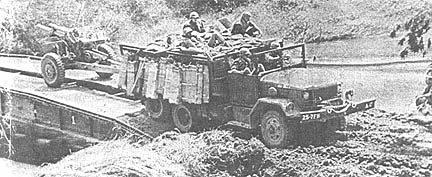 |
AN ARTILLERY PIECE from A Battery, 7th Battalion, 11th Artillery rumbles across the quickly-laid span. (PHOTOS BY SP4 HERB BERDETT) |
| HAVE GUN, WILL TRAVEL - This CH-47 airlifts a B Battery, 2d Battalion, 13th Artillery 105mm Howitzer into position at Fire Support Base Patton, secured by the 2d Brigade's 4th Battalion, 9th Infantry Manchus. (PHOTO BY PFC H. J. TSCHIRNER) | 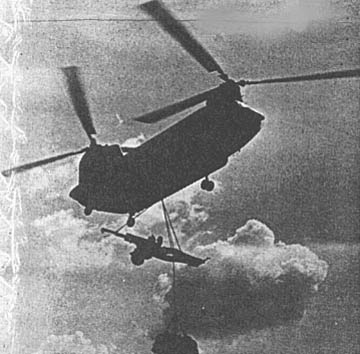 |
Arty Boasts Mobility
CU CHI - The ability of artillery to keep up with the infantry
anytime, anywhere, is a vital factor in the success of ground operations
throughout the Republic of Vietnam.
Recently, B Battery, 7th Battalion, 11th Artillery began a
clearance operation of Fire Support Base Hines and demonstrated again the
ability to quickly react to infantry plans.
The clearance operation was accomplished by means of air
mobilization. Earlier, B Battery had been sent to a field position near
the Cambodian border. The reason for this location was that a VC supply
route was suspected in the area.
Their mission was to fire artillery support for the 1st Battalion,
27th Infantry Wolfhounds. The six days at FSB Hines were spent firing,
building bunkers and securing their position. During this period, B
battery fired more than one thousand prep rounds for infantry maneuvers.
Upon completion of their mission the clearance operation began.
Airlifting from the field to the base camp is definitely a
large-scale operation. In fact, the whole fire support base is literally
picked up and airlifted back to the base camp.
In the course of the operation, 35 round trips were made by the
Chinooks and Sky Cranes. Whole loads weighed approximately 8,000 and
14,000 pounds, respectively.
The resupply pad at Tay Ninh base camp was a rush of constant
activity. The big choppers would come in and drop off loads, which were
quickly loaded onto trucks that had to move out immediately in order to make
room for the next drop. The action took place in the midst of swirling,
stinging winds and the thunderous noise caused by the mighty aircrafts.
Despite these constant hazards, the operation came off smoothly,
swiftly and in a professional manner. The air transportation was supplied
by the 2d Battalion, 22d Aviation, Vung Tau, and the 242d Helicopter
Muleskinner's Company, Aviation Battalion, Cu Chi. Working with the
helicopters were the 25th Aviation Battalion, Pathfinders Detachment.
The clearance of FSB Hines and the air mobilization of B Battery,
7th Battalion, 11th Artillery, was a complete success. The entire
operation took but four hours and is not only an amazing accomplishment but a
credit to the United States Army and all personnel involved.
Page 2 TROPIC LIGHTNING NEWS December 2, 1968
Decorated
| BRONZE STAR
MEDAL (HEROISM) |
|
|
CPT Harry Ikner, C Co, 2d Bn, 27th Inf CPT Gordon Lam, A Co, 4th Bn, 23d Inf CPT Keith Wilks, HHC, 2d Bn, 14th Inf 1LT John Farley, D Co, 2d Bn, 27th Inf 1LT Joseph Rio, C Co, 4th Bn, 23d Inf 1LT James Carper, HHC, 3d Bn, 22d Inf 1LT James Valentine, A Btry, 3d Bn, 13th Arty 1LT David Williams, B Co, 1st Bn, 5th Inf 1LT Paul Cline, C Co, 1.st Bn, 5th Inf 1LT Dennis Crawford, A Btry, 1st Bn, 8th Arty 1LT Thomas Arthur, Adv Tm 99, 25th Inf Div 1LT Robert Dehlinger, B Co, 1st Bn, 5th Inf SSG Richard Morgan, A Btry, 1st Bn, 8th Arty SSG Otto Brown, A Co, 25th Avn Bn SSG Darreld Brawley, D Co, 2d Bn, 14th Inf SSG Gaston Green, 25th MP Co SSG Richard Glover, C Co, 2d Bn, 27th Inf SSG Gerald Daniel, 25th MP Co SGT Henry Lapidus, D Co, 2d Bn, 14th Inf SGT Willie Caston, 25th MP Co SGT Billy Terry, A Co, 1st Bn, 27th Inf SGT Sammy Johnson, A Btry, 3d Bn, 13th Arty SGT Robert Lynch, C Btry, 7th Bn, 11th Arty SGT William Smith, A Btrq, 1st Bn,,Sth Arty SGT Olen Weaver, HHC, 2d Bn, 22d Inf SGT Ronald Theel, B Co, 3d Bn, 22d Inf SGT Elroy Miller, C Co, 1st Bn, 5th Inf SGT William Vance, D Co, 65th Engr Bn SGT George Sharke, A Co, 1st Bn, 5th Inf SGT Phillip Lambert, A Co, 1st Bn, 5th Inf SGT James Wallade, D Co, 2d Bn, 27th Inf SGT James Waldron, B Co, 1st Bn, 5th Inf SP5 Robert Bundy, HHC, 4th Bn, 23d Inf |
SP5 Ernest Decoito, A Co, 25th Avn Bn SP4 George Walker, C Co, 4th Bn, 23d Inf SP4 Grafton Layer, HHC, 3d Bn, 22d Inf SP4 Joseph Baltuska, A Co, 1st Bn, 5th Inf SP4 Marc Magee, C Co, 4th Bn, 23d Inf SP4 Gary Robinson, HHC, 3d Bn, 22d Inf SP4 Earl Henson, D Co, 65th Engr Bn SP4 Danny Alvis, HHC, 3d Bn, 22d Inf SP4 Trellis Grubbs, A Co, 1st Bn, 27th Inf PFC Richard Owen, B Co, 2d Bn, 27th Inf PFC Rodney Crane, D Co, 2d Bn, 14th Inf PFC Jose DeElena, B Co, 2d,Bn, 27th Inf PFC John Mann, B Co, 2d Bn, 27th Inf PFC Edward Parker, C Co, 4th Bn, 23d Inf PFC Donald Oldaker, A Co, 1st Bn, 27th Inf PFC Robert Hiner, B Co, 4th Bn, 23d Inf PFC Raymond Barker, D Co, 1st Bn, 5th Inf PFC Gary Sheets, C Co, 1st Bn, 5th Inf PFC David Pelletier, C Co, 1st Bn, 5th Inf PFC Jose Romo, D Co, 1st Bn, 5th Inf PFC Thomas O'Neil, A Co, 1st Bn, 5th Inf PFC James Fant, A Co, 1st Bn, 5th Inf PFC Jose Fejeran, A Trp, 3d Sqdn, 4th Cav PFC Joseph Nenning, A Btry, 3d En, 13th Arty PFC Jaime Bornacelli, B Co, 4h Bn, 23d Inf PFC James Johnson, B Co, 4th Bn, 23d Inf PFC Gary Robinson, B Co, 3d Bn, 22d Inf PFC William Moreland, A Co, 2d Bn, 14th Inf PFC John Gardner, A Co, 2d Bn, 22d Inf PFC Dow Tiliman, B Co, 2d Bn, 27th Inf PFC John Trease, C Co, 1st Bn, 5th Inf PVT Keith Sherman, D Co, 1st Bn, 5th Inf |
More Support To Troops
The Vietnam Regional Exchange has started a massive program to move
merchandise from stores in the support areas where combat troops are. As a
result, men in the field soon will have access to more Exchange goods than ever
before.
In essence, the new policy means that such popular items as
cameras, watches, small radios and tape recorders now will be distributed to
Exchange facilities according to troop strength. In the past, such
merchandise was distributed on the basis of previous sales - stores that sold
the most obtained proportionately more merchandise.
"This was the case of the rich becoming richer," Colonel John
R. McDonald, VRE commander, said, "Our basic purpose is to get the material to
the troops."
Since his arrival in Vietnam in late August, McDonald has met with
General Creighton W. Abrams, commanding general of U.S. Forces in Vietnam, and
numerous other top-level commanders in the theatre. In every instance,
McDonald said, the commanders expressed "the desire of maximum support to the
troops in the foxhole."
2d Brigade Clerk Gets Commission
In a ceremony in the office of 2d Brigade Commander, Colonel Eugene
M. Lynch, John D. Allen received his commission to second lieutenant.
Allen, formerly specialist 4 and a clerk-typist in the Brigade's
civic action office, received the direct commission in the quartermaster corps.
Before coming to the Fire Brigade, Allen was a clerk in the
adjutant general officer's records branch.
Allen obtained his Master's degree in business administration
from the University of Rochester, Rochester, N.Y.
Allen's first assignment as an officer is with the Americal
Division in Long Binh.
Tropic Lightning Tots
The Commanding General Welcomes
The Following Tropic Lightning Tots
To The 25th Infantry Division – As
Reported By The American Red Cross.
Born To:
|
November 10 |
Tropic
Lightning
Combat Honor Roll
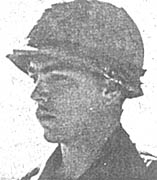 Added to this week's Combat Honor Roll is Specialist. Four John
A. Scott of Company B, 2d Battalion, 12th Infantry.
Added to this week's Combat Honor Roll is Specialist. Four John
A. Scott of Company B, 2d Battalion, 12th Infantry.
Scott distinguished himself by heroic actions on October 7, 1968
while serving as a radio telephone operator.
During a combat operation near the enemy-infested village of Tam
Dinh, his company came under devastating hostile fire from well-concealed
bunkers within the village.
Scott exposed himself to the withering hostile fire as he manned
his radio and relayed information throughout the battle-torn area.
When his platoon sergeant was mortally wounded, Scott, continually
exposed himself to the fire to try to reach his fallen comrade.
The fire was too much, so he returned to his radio which lay across
the enemy's kill zone, and directed suppressive fire on the insurgents.
His personal bravery, aggressiveness, and devotion to duty are in
keeping with the highest traditions of the military service and reflect great
credit upon himself, his unit, the 25th Infantry Division and the United States
Army.
The TROPIC LIGHTNING NEWS is an authorized publication of the 25th
Infantry Division. It is published weekly for all division units in the Republic of
Vietnam by the Information Office, 25th Infantry Division, APO San Francisco
96225. Army News Features, Army Photo Features, Armed Forces Press Service and Armed
Forces News Bureau material are used. Views and opinions expressed are not necessarily
those of the Department of the Army. Printed in Tokyo, Japan, by Pacific Stars and
Stripes.
MG Ellis W. Williamson . . . . Commanding General
MAJ Andrew J. Sullivan . . . Information Officer
2LT Don A. Eriksson . . . . . . Officer-in-Charge
SP4 Stephen Lochen . . . . . . Editor
SP4 \Robert C. Imler . . . . . . . Asst. Editor
SP4 Tom Quinn . . . . . . . . . . Production Supervisor
Page 3 TROPIC LIGHTNING NEWS December 2, 1968
Serviceman's Medicare Program
Offers Important fringe
Benefits
Military medicare is one of the major fringe benefits for millions
of American service families. But few realize the vast scope of benefits
available or fully understand the recently revised procedures for participating
in the program.
To aid the serviceman, the Family Service Center in Washington,
D.C. has prepared a new edition of its special report on medicare for Armed
Forces active duty dependents.
The report explains in detail all new regulations which now affect
the Civilian Health and Medical Program for the Uniformed Services (CHAMPUS).
For example, it notes the government's position on
"unreasonable" doctor's fees and outlines the steps you must take to
insure that your physician is "participating" in the CHAMPUS program.
If you neglect to take the necessary steps, you may be liable for a
larger part of the physician's bill than you expected.
The new report covers all phases of military medicare including
dependent treatment by civilian physicians in and out of civilian hospitals, and
by military medics in service facilities. The report also explains how much you pay to the doctor or
hospital and what portion of the bill the government pays, as well as how to get
reimbursed if you've paid too much.
Home nursing is now authorized and the report outlines what is
covered.
Also included is a warning against getting treatment in a hospital
practicing racial discrimination.
A copy of this report is available free by sending a stamped,
self-addressed business-size envelope to the Family Service Center, 475 School
Street, SW, Washington, D.C. 20024. Ask for Report Number 100.
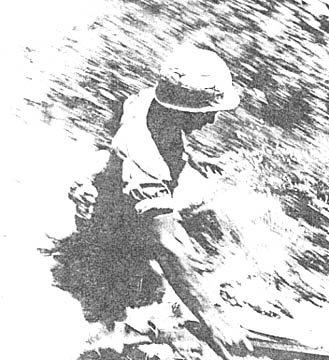 |
TRY AGAIN - Specialist 4 Presslet Phillips, a mortarman with Company A, 2d Battalion, 27th Infantry Wolfhounds, from Gostoria, N.C., tries his luck at stream jumping. The action took place northwest of Saigon. The 2d Brigade trooper's luck seems to have run out that day. (PHOTO BY SP4 BILL CLEVENGER) |
Stay On The Team
Everyone in the armed forces knows how important teamwork is in
military applications. Whether on a reconnaissance patrol or simply in the
smooth flow of work through an office, it is readily apparent how teamwork makes
for efficiency. Each person does his job, his efforts mesh neatly with
those of others on the team, and the over-all mission of the team is
accomplished.
Drug abuse can destroy that effective teamwork. If one member
is under the influence of drugs, the efficiency of the entire team is almost
certain to be impaired.
According to the World Health Organization, among the more
prominent effects of marijuana are carelessness, distortion of sensation and
perception, impairment of judgment and memory and confusion.
Imagine the consequences to a combat patrol where each member is
dependent on the other, if one of them is a "pot" smoker, subject to any one
or a combination of these effects.
The effects of marijuana or any of the other hallucinogens can be
equally disastrous in non-combat situations. On a ship or an aircraft the
lives of many men may depend on how efficiently the operator of a sophisticated
piece of navigational equipment does his job. What happens if that
operator decides to "take a trip" while he's on duty?
We've only raised the question of what can happen through use of
the so-called non-addictive drugs - the ones some people might tell you are
"harmless!" Add to this the serious and addictive physical effects of
narcotics, sedatives, tranquilizers and stimulants, and the picture becomes even
more appalling.
The cold, hard facts about drugs and their effects are available
from many sources. We recommend that each service man and woman become
well-informed on the subject.
Armed with this knowledge, we doubt that any real "team player"
will want to experiment with drugs. Nor do we feel he will long tolerate
on his team a member who has become what might he termed a "deadly
drop-out." (AFPS)
Christmas Gifts
Each man in the 25th Infantry Division and attached units will be
receiving Red Cross Christmas gift parcels (ditty bags). The parcels
contain vacuum-packed tins of nuts, fruits, candies, cakes, as well as lighters,
pen flashlights and playing cards.
A project officer will be appointed from each battalion, separate
company, or detachment under the code name, 'Project 60'. Names must
be furnished to First Lieutenant Nester (telephone 5044) on or before 10
December.
| PAUSING FOR A MOMENT - A platoon leader and RTO from the 2d Battalion, 12th Infantry take a breather during a sweep north of Cu Chi. (PHOTO BY SP4 CHARLES HAUGHEY) | 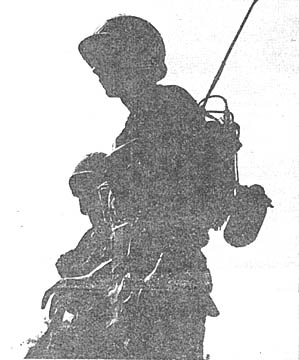 |
Patient Wait Pays Off Wolfhounds
As the figure approached, Private First Class Kenneth Mattson could
not tell if he was friendly or not. The night ambush to his left had just
been sprung and one of their men could have become separated.
As the lone figure got closer the two came face to face. A
point blank shootout ensued. The result, one dead enemy and a captured
AK-47.
Mattson, a 20-year-old ammo bearer from Bravo Company, 2d
Battalion, 27th Infantry Wolfhounds had been on the left flank of the ambush
patrol when he spotted the VC on the berm.
The Colliersville, Tenn., soldier later explained, "I couldn't
tell for sure whether or not he was friendly. I didn't shoot at first
because he seemed to be making his way to us as if he knew we were there.
By the time he had recovered from meeting me face to face, it was already too
late, and he was on his way down."
| FINISHED FOR THE NIGHT - The men of Charlie Company, 1st Battalion, 27th Infantry Wolfhounds, return from a night ambush. (PHOTO BY SP4 HECTOR NADAL) | 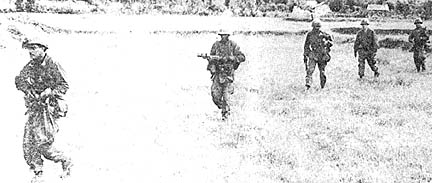 |
Page 4-5 TROPIC LIGHTNING NEWS December 2, 1968
1st Bde Spearheads Deep Drive
Into Jungles of War Zone C
By 2LT Mack D. Gooding
CU CHI - Major General Ellis W. Williamson, commanding general of
the 25th Infantry Division, and Colonel Nguyen Quan Thong, province chief of Tay
Ninh Province combined elements of the 1st Brigade and Regional Forces to
conduct operations around Thien Ngon, in northern Tay Ninh Province.
Thien Ngon lies three and a half miles south and six and a half
miles east of the Cambodian border on strategic Route 22. One of the major
objectives of this operation is to clear the area of Viet Cong and North
Vietnamese Army units to allow resettlement of War Zone C by South Vietnamese
civilians.
Two companies of the 4th Battalion (Mechanized), 23d Infantry,
under Lieutenant Colonel Clifford Neilson, of Mobile, Ala., and two companies of
the 3rd Battalion, 22nd Infantry, commanded by Lieutenant Colonel Alex H. Hunt,
of Wealder, Tex., began the sweep of Route 22 from Tay Ninh Forward Operations
Base to Thien Ngon, 30 miles to the north. The armored column was greeted
at Thien Ngon by the 101st Regional Force company and Colonel Thong.
Troops from the Tropic Lightning Division and the 161st Regional
Force Company under Colonel Thong and Colonel Robert L. Fair, commanding officer
of the 1st Brigade, executed combined operations within the shadow of the
Cambodian border.
Elements of the 1st Brigade swept strategic Route 22 to Thien Ngon,
combining forces with the 161st Regional Force Company at the civilian irregular
defense group camp. When the two forces linked up, they began
reconnaissance-in-force operations in the area.
The operation around Thien Ngon was a first in many respects: It
was the first time a Regional Force Colonel and a U.S. Colonel together directed
combined forces of battalion size. It was the first time that an armored
column moved, in force, into northwestern Tay Ninh Province. It was the
first time vital Route 22 was used to resupply a large element in the field.
Comments heard after the first day of action by some of the
Americans reflected the admiration and confidence they have in their Vietnamese
counterparts.
Fighting as they did, one could not draw a distinction and say,
"That's a U.S. soldier over there and an RF over there." They fought as
one.
The opening and use of Route 22 by Americans and Vietnamese forces
denies the use of this route to the Viet Cong, significantly reducing
Charlie's capability of movement of men and supplies in this area.
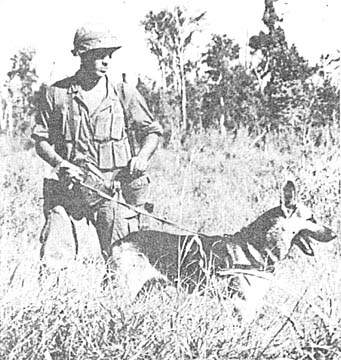 |
SOLDIER AND SCOUT DOG - Specialist 4 Del Troujillo, of Las Vegas, N V., and his scout dog, Smokey, both with the 46th Scout Dog Platoon, prepare to lead a sweep team from C Company, 3d Battalion, 22d Infantry on a search-and-secure mission near the Cambodian Border. (PHOTO BY SP4 HERB BURDETT) |
| TRACKS RUMBLE NORTH - An armored convoy of combined 25th Division and Regional Forces move into War Zone C. The operation is designed to open the area for resettlement by civilians. (PHOTO BY SP4 DON BROWN) | 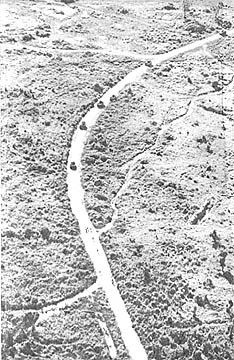 |
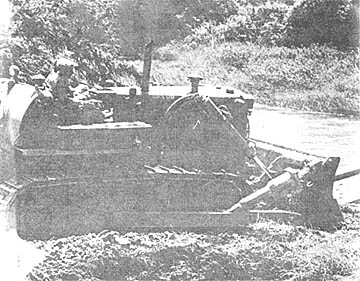 |
BRIDGE GOING UP - A bulldozer from A Company, 65th Engineers levels the ground on the far side of the river before mechanized units and convoy vehicles from Tay Ninh City rolled across the bridge. (PHOTO BY SP4 HERB BURDETT) |
| BRIDGE IN PLACE - Like a giant claw reaching out for its prey, an armored vehicle launching bridge stretches to reach the far bank of the Soui Tri Bi River. (PHOTO BY SP4 HERB BURDETT) | 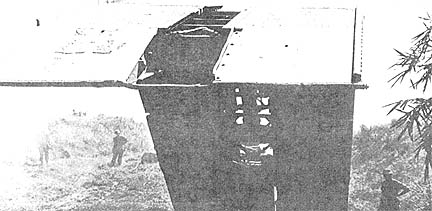 |
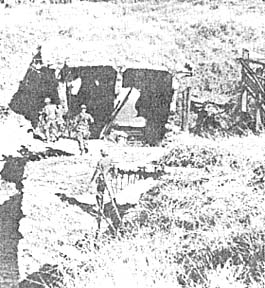 |
SECURING BRIDGE SITE - Men of C Company, 3d Battalion, 22d Infantry, move across the foundations of a demolished bridge on the Suoi Tri Bi River. |
| APC ON THE MOVE - An armored personnel carrier from the 4th Battalion, 23d Infantry rolls across the launching bridge. (PHOTO BY SP4 HERB BURDETT) | 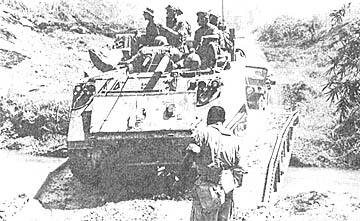 |
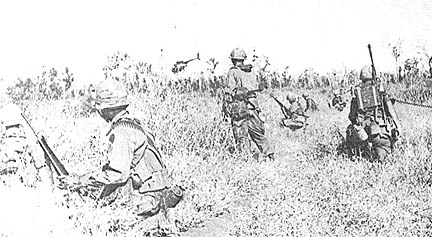 |
| WAR ZONE C - Regulars from C Company, 3d Battalion, 22d Infantry prepare to move out on an important search and secure mission. This 1st Brigade unit was operating in the heart of War Zone C. (PHOTO BY SP4 HERB BURDETT) |
Page 6 TROPIC LIGHTNING NEWS December 2, 1968
ARTY Changes Enemy's Route,
VC WaIk Into Wolfhound Trap
CU CHI - A 2d Brigade company commander with the aid of artillery
walked five VC into an ambush, killing four enemy and capturing five enemy
weapons.
Captain Harry L. Ikner, CO of Company C, 2d Battalion, 27th
Infantry Wolfhounds, along with his forward observer set up an observation post
situated so that all three of his elements could be observed as well as the
surrounding area.
It was around 11 p.m. that five enemy were seen leaving a small
village heading into the open fields out of the range of his waiting elements.
By directing artillery fire he successfully changed the enemy's course three
times until they walked directly into his waiting ambush.
Second Lieutenant James O'Brien, the platoon leader who sprung
the ambush, said, "We had been notified that the enemy was headed in our
direction, but because of the terrain we were unable to see them until they were
right on us.
A search of the area the following morning revealed four enemy
dead, two AK-50s' and one AK-47. The bodies were dressed in NVA
uniforms, and assorted NVA web gear was captured.
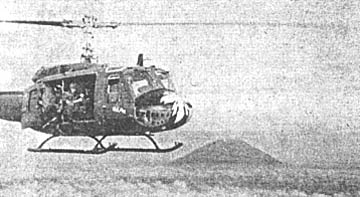 |
HORNET BUZZES MOUNTAIN - Carrying Wolfhounds, a Hornet helicopter of the 116th Assault Helicopter Company passes near Nui Ba Den, the Black Virgin Mountain. The 3d Brigade soldiers were enroute to a sweep which turned up four Viet Cong and 28 detainees. (PHOTO BY SP4 HECTOR NADAL) |
Grenade Magic Yields Cache Find
DAU TIENG - "Almost like magic, a trap door opened at my feet."
As in an episode from the 1,001 Arabian Nights, the opening of the
entrance to a cave yielded the glimmer of treasure for Bobcats of the 1st
Battalion (Mech), 5th Infantry.
The trap door opened in front of First Lieutenant Ronald J. Clary
of Gruver, Tex., just after one of his infantrymen had tossed a grenade down an
air vent to an enemy bunker, 45 miles northwest of Saigon.
The platoon leader for Bravo Company of the 3d Brigade battalion
was sweeping an area as part of a security operation for the 168th Land Clearing
Company (Prov), which is knocking down scrub forest long notorious as an enemy
stronghold.
"When the trap door opened, we followed a short tunnel into a
room 10 feet long, 15 feet wide and six feet high," said Clary.
The underground vault yielded more than 50,000 rounds of.enemy
AK-47 assault rifle ammunition, 3,500 rounds of 12.7mm machinegun ammo, 190
Chicom rifle grenades, and three large pressure-type anti-tank mines.
Commenting on the imposing find, Captain Gregory Hayward said,
"Maybe the magic words have changed, but the results haven't."
Medics' Airlift MEDCAP Treats Over 150 Patients
TAY NINH - Medics of the 2nd Battalion, 22d Infantry recently
airlifted into an area ten miles north of Tay Ninh City to conduct a medical
civic action program (MEDCAP) for the hundreds of people living in Xa Tan Hung
village.
While Company A of the 3d Battalion secured the area, Captain Alden
Sweatman of Columbia, S.C. the battalion surgeon and his assistant operations
officer, First Lieutenant Richard Booth of Anaconda, Mont., combined with the
battalion's team of medics to treat over a hundred and fifty patients.
"The village was very quaint, with neatly thatched roofs, but you
could tell that the people were somewhat on the needy side," said Sweatman.
"The inhabitants of the village are members of a group of Vietnamese people
that resemble Cambodians in appearance, are of Chinese origin, and at one time
lived quite near Tay Ninh City," continued Sweatman.
"There were animals running all over the place, just like back on
an Indiana farm," said Booth. "Many of the women were squatting down cooking
fish over hot rocks. The fish were skewered on the ends of sharply pointed
sticks. It was a very primitive scene."
"In addition to medical supplies and soap, over 400 pounds of
rice were also distributed to the villagers," said Sweatman. "The
village chief had them all line up in an orderly fashion while he gave each one
a fair portion of rice. There was no mass confusion and hysterical
grabbing for supplies."
During the months of September and October, the 3d Battalion has
administered medical aid to over 1200 patients in the course of their many civic
action projects in the Tay Ninh area.
Wolfhound Eliminates VC Snipers
DAU TIENG - One Viet Cong sniper was killed and two wounded after
they fired at a helicopter leaving a 3d Brigade, fire support base.
The snipers, lurking near the edge of the hamlet of Thanh An, 38
miles northwest of Saigon, were spotted by members of the reconnaissance platoon
of the 1st Battalion, 27th Infantry Wolfhounds.
The recon platoon moved toward the hamlet and received sniper fire
when they were about 50 meters away. But, as First Lieutenant Keith Davis
of Chicago, Ill., platoon leader, led the assault, the Wolfhounds quickly
overran the sniper position.
After finding the body of the dead sniper and detaining the two
wounded, the reconnaissance soldiers began searching a bunker complex.
They quickly found several North Vietnamese Army uniforms and small items.
Interrogation of villagers led them to a woman who was said to be
the wife of an enemy platoon leader. She reportedly was supplying the VC
with food.
Specialist 4 James Krudop of Fort Wayne, Ind., volunteered to
search a network of subterranean tunnels and chambers. Not much was found,
but Krudop was able to follow the complex out to a woodline outside the village.
Page 7 TROPIC LIGHTNING NEWS December 2, 1968
MEDCAP And Civic Action A Welcome Break From War
TAY NINH - In a war that has many different aspects as the one in
Vietnam, there are many non-combat battles to be fought. One of the
biggest battles is for the faith, respect and confidence of the Vietnamese
people.
Two programs instituted by the U.S. Army to help accomplish this
task are MEDCAP (medical civic action program) and civic action programs.
Lieutenant Colonel Arthur H. Seabrook, 1st Brigade civil affairs
officer, from Charleston, S.C., heads these programs in the brigade's area of
operation.
"Our main emphasis has been the schools within Tay Ninh province.
The future of Vietnam lies in its schools and this is where we can be most
effective."
One civic action program consisted of building a flagpole and stand
for the Long Hoa Elementary School in Tay Ninh City. Materials donated
under the self-help program consisted of 2,500 bricks, 20 bags of cement, a
25-foot pole and 3 cubic meters of gravel and sand. There was also a need
for school supplies. School kits, writing tablets, rulers, pens, pencils
and ink were provided for 110 Long Hoa school children.
"During the month of October we also put a lot of emphasis on
health standards throughout the province. We conducted 65 MEDCAPs,
treating 7,072 patients," recalled Seabrook.
"The children are the ones who give us the most satisfaction on
MEDCAPs," stated Captain Charlie W. Smith, from Atlanta, Ga., assistant civil
affairs officer for the 1st Brigade. "We passed out 75 health kits to
children in the Cao Dai Orphanage.
"To see their expression of gratitude when they receive these
health kits is worth a million dollars,"' Smith said.
Civil action personnel saw the children's smiles widen a little
further when they distributed rubber balls, kites and T-shirts during MEDCAP.
Over 160 T-shirts with the slogan, "Your future lies with GVN, I support GVN,"
were given out to children within Tay Ninh Province.
A joint 1st Brigade, Philippine civic action group (PHILCAG)
project during October involved the repairing of the Long Hoa dispensary.
This self-help project needed 15 gallons of paint and 15 concrete downspouts
which were provided by the 1st Brigade, PHILCAG donated a labor team that
repaired the dispensary's walls and roof.
"Next month we plan to put even more emphasis on self-help
programs and MEDCAPs," commented Seabrook.
|
STORY AND PHOTOS BY CPT LES RASCHKO |
Page 8 TROPIC LIGHTNING NEWS December 2, 1968
Manchus Capture Five Tons Of Rice In Five Days
DAU TIENG - During a coordinated five-day bushmaster operation in
early November elements of C and D Companies of the 4th Battalion, 9th Infantry
discovered three separate rice caches containing a total of 97 one hundred pound
bags of rice.
While the 3rd platoon of Delta Company was reconning-by-fire First
Lieutenant Robert G. Hoehn, Jr. of Aiken, S.C., noticed that a tracer had
ignited a small fire in a nearby hedgerow. Investigation netted a
5000-pound find camouflaged in dense brush near the mushroom of the Saigon
River, six miles north of Trung Lap.
The same day, as elements of Charlie Company swept a nearby area,
Specialist 4 Carl Olin of Phoenix, Arizona found thirteen 100-pound bags that he
described as being "stacked like a bunker."
A closer search, ordered by Company Commander Captain Carl J.
Winter of Hemlock, Michigan revealed an additional 34 bags hidden in a hedgerow
about 30 meters away.
The total 9700 pounds of enemy rice was evacuated to 2d Brigade
Headquarters where First Brigade Civic Action personnel will distribute to local
civilians.
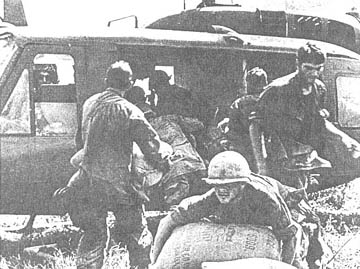 |
RICE - While a 'Hornet' slick waits, Delta Company, 4th Battalion, 9th Infantry Manchus hustle to load some of the 50 one-hundred pound bags of rice captured during a bushmaster operation six miles north of Trang Bang. (PHOTO BY PFC H. J. TSCHIRNER) |
VIP: Pay As You Go For Cache Information
TAY NINH - New methods are being used to push an old information
program. The program, Valuable Information Program, (VIP), was first
initiated several years ago. VIP will give the Vietnamese people a chance
to pocket a few extra dollars for reporting and turning in enemy weapons.
At first, little information was gained as a result of VIP,
causing. the program to drift into the background. Within the last month,
new emphasis has been placed on VIP. The importance of this program is
finally coming to the surface. It gives the Vietnamese people incentives
to report their findings and helps save American lives.
A pay scale has been prepared ranging from a few cents for small
arms ammo to a maximum of $100.00 for artillery pieces. The list provides
the minimum amount to be paid. It is realized that local situations may
make higher payment desirable.
The new push on VIP has already brought results. While
sweeping Highway 26 toward French Fort, Alpha Company, 4th Battalion
(Mechanized), 23rd Infantry, commanded by Captain David Beach of Chicago, came
upon a small boy standing in the road pointing to the ground. The
boy told Captain Beach, using hand gestures, that a VC mine was in the road.
Captain Beach immediately radioed the battalion commander,
Lieutenant Colonel Clifford C. Neilson, of Mobile, Ala., who was surveying the
scene from the air. Upon receiving the report Neilson landed to check out
the report. The small boy was right. The mine was removed,
eliminating that source of destruction.
"This is a fine example of the VIP program at work," said
Neilson as he handed the boy 2,900 piasters.
"Enough emphasis can never be placed upon a program designed to
save American lives," he said.
What The Bombing Halt Means To You
With the cessation of the bombing of the North, one of the major
conditions for peace would seem to have been met; but war still must be waged
daily against an evasive and determined enemy. How the average American
soldier fits into this picture is explained in a recent USARV fact sheet.
First, review some of the events of the past few months to see what
has been done by the United States in an attempt to resolve the Vietnam conflict
in a fast but honorable way.
To understand the United States' position with regard to the
conflict in South Vietnam, examine the goals stated at the conclusion of the
October 1966 Manila conference. This conference was attended by President
Johnson, the Government of Vietnam and representatives of all the Free World
military assistance forces fighting in South Vietnam. At the time, it was
agreed that:
1. Allied forces shall be withdrawn, after close consultation
with the Government of Vietnam and the other troop contributing nations, as the
military and subversive forces of North Vietnam are withdrawn to the North.
2. Infiltration ceases; and
3. The level of violence subsides.
In September 1967, President Johnson outlined a proposal which he
hoped would lead to negotiations and peace. This proposal, referred to as
the 'San Antonio Formula' made clear that the United States would stop
bombing North Vietnam when such action would lead to productive peace talks and
not be used by the North Vietnamese for military advantage. This offer was
rejected by Hanoi on 3 October 1967.
The communist offensives during 1968, commencing with the Tet
offensive in late January 1968, proved to be a major turning point in the
conflict. The enemy hopes for an uprising of the South Vietnamese people
in his support. It did not occur. Not only was the enemy soundly
defeated in this political objective, but his military forces were badly
battered. Allied forces seized the initiative and kept it.
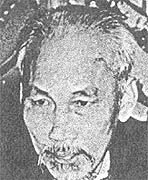 On March 31st, 1968, President Johnson made yet another effort to
bring the conflict to the negotiating table. He said at that time:
"Tonight I renew the offer I made last August - to stop the bombardment of
North Vietnam. Tonight I have ordered our aircraft and our naval vessels
to make no attacks on North Vie
On March 31st, 1968, President Johnson made yet another effort to
bring the conflict to the negotiating table. He said at that time:
"Tonight I renew the offer I made last August - to stop the bombardment of
North Vietnam. Tonight I have ordered our aircraft and our naval vessels
to make no attacks on North Vie
tnam except in the area north of the
Demilitarized Zone. Even this very limited bombing of the North could come
to an early end - if our restraint is matched by restraint in Hanoi."
Bombing of North Vietnam above the 19th parallel was halted.
This de-escalation was made as a test of the good faith of the North Vietnamese,
and resulted in their willingness to meet with the United States in Paris for
negotiations which we hoped would lead to peace.
The talks got underway on May 10 while fighting in South Vietnam
continued. For quite a few months the discussions were nonproductive and
appeared to be deadlocked. A few weeks ago, however, they entered a new,
more hopeful phase.
In an announcement of the bombing halt on October 31st; the
President stated: "We have reached the stage where productive talks can begin.
We have made it clear to the other side that such talks cannot continue if they
take military advantage of them."
It must be understood that the bombing halt does not mean a halt in
fighting in South Vietnam. The current negotiations will take more time,
and hard fighting will continue. Although the enemy has suffered severe
reverses militarily, he still has the capability to continue his aggression in
the South. Military pressure has forced the enemy to agree to what we hope
can be meaningful discussions in Paris. This military pressure must
continue unabated in South Vietnam to ensure that these discussions do lead to
peace.
Every possible step is being taken to be sure the enemy does not
take advantage of the bombing halt. Commanders have been authorized and
directed to take any and all actions necessary to defend any unit anywhere in
South Vietnam. The choice is now the enemy's: further de-escalation or
further destruction.
Thanks to
Ron Leonard, 25th Aviation Bn., for locating and mailing this issue,
Kirk Ramsey, 2nd Bn., 14th Inf. for creating this page.
This page last modified 8-12-2004
©2004 25th Infantry Division Association. All rights reserved.